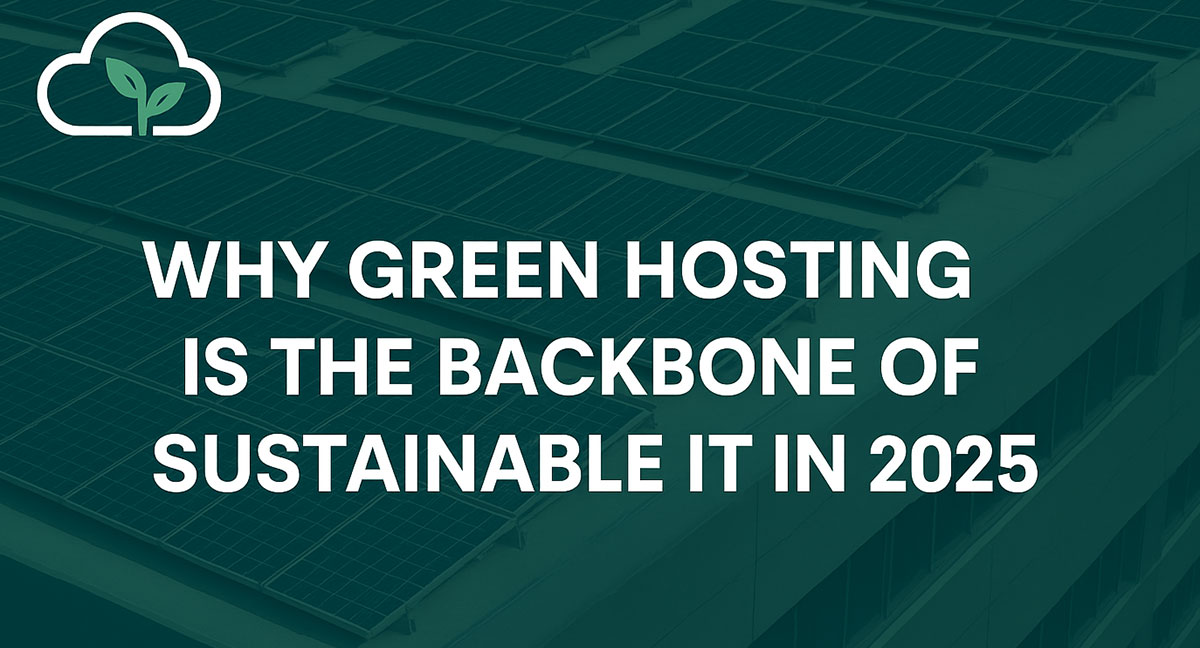No products in the cart.
 The Urgency of IT Sustainability
The Urgency of IT Sustainability
In 2025, sustainability is no longer a nice to have it’s a critical component of IT strategy. As a result, as digital infrastructure scales and environmental regulations tighten globally, the IT sector faces increasing scrutiny for its energy consumption and carbon footprint. Consequently, today’s organizations must answer not just how well their systems perform, but also how efficiently and responsibly they operate.
One of the most impactful developments in this space is green hosting – a model of hosting services powered by renewable energy, optimized for efficiency, and aligned with global sustainability goals. In fact, it’s not just about environmental goodwill – rather, it’s a strategic imperative.
The Shift Toward Green IT
A decade ago, IT sustainability was mostly symbolic – energy-saving hardware or carbon credits. However, in 2025, it’s a regulatory, ethical, and business-driven priority. Driven by this shift, regulatory pressure from frameworks like the EU Green Deal and the SEC’s climate disclosure mandates is forcing companies to integrate environmental goals into daily operations. At the same time, customers are making eco-conscious purchasing decisions, and as a result, enterprises are reassessing how their digital services impact the planet.
As a result, green hosting and eco-friendly IT practices have moved from fringe initiatives to central components of corporate strategy.
What Does Green Hosting Mean in 2025?
Green hosting has evolved far beyond token gestures like tree planting or offset programs. In today’s context, it represents a holistic approach to sustainable computing. Specifically, key features include:
- Carbon-neutral servers powered by wind, solar, or hydro energy
- Smart energy grids and battery-based backup systems replacing diesel generators
- Sustainable supply chains, where hardware is sourced from ethical and energy-conscious manufacturers
- Transparent emissions tracking, allowing clients to monitor their carbon usage
The goal? To achieve sustainability goals without sacrificing system performance, uptime reliability, or growth potential.
Modern Data Centers: Efficient and Eco-Friendly
While data centers are essential to delivering digital experiences, they also represent one of the highest energy demands in modern IT infrastructure. However, in 2025, innovation in this area is actively redefining what a green data center looks like:
- By adapting to real-time server activity, AI-based cooling systems enhance airflow management while cutting down on unnecessary energy usage.
- Modular designs allow facilities to scale only as needed, avoiding over-provisioning
- Immersion cooling technology is gaining momentum, submerging servers in non-conductive fluids to enhance heat dissipation and reduce electricity consumption
- Power Usage Effectiveness (PUE) metrics guide real-time operational adjustments for efficiency
These innovations not only reduce carbon output but also extend hardware lifespans-lowering costs and environmental impact simultaneously.
Sustainability as Core IT Strategy
Once limited to compliance checklists, Environmental, Social, and Governance (ESG) policies now actively shape procurement, vendor selection, infrastructure design, and day-to-day IT management. Moreover, frameworks such as the GRI (Global Reporting Initiative) and SASB (Sustainability Accounting Standards Board) provide structured guidelines for integrating sustainability into business operations.
Forward-looking organizations now proactively track emissions from data flow, hardware lifecycle, and even third-party integrations, demonstrating that IT sustainability is no longer a back-office concern – instead, it’s a frontline priority.
Top Green Hosting Providers in 2025
Several providers are leading the charge in green hosting innovation:
- GreenGeeks offsets its energy usage with a 300% renewable energy match and upholds transparent sustainability standards.
- IONOS – Operates carbon-neutral data centers across Europe and the U.S.
- Cloudflare Green Compute – Offers developers tools to measure and reduce computing emissions
These companies provide more than just server space – in addition, they deliver real-time carbon monitoring dashboards, net-zero commitments, and partnerships with renewable energy providers. Ultimately, their value proposition lies in aligning hosting services with the sustainability goals of their clients.
Why Going Green Pays Off
Sustainable IT infrastructure isn’t just good for the planet-it drives measurable ROI. Companies that adopt green hosting enjoy:
- Lower energy bills through improved power efficiency
- Extended hardware longevity, minimizing costly replacements
- Enhanced brand trust among younger demographics, including Gen Z and millennials.
- Stronger investor interest, as ESG-aligned businesses outperform peers
- Risk mitigation, especially with looming carbon taxes and compliance requirements
With these benefits, green IT is proving both recession-resilient and future-ready.
Challenges and How to Overcome Them
Transitioning to a sustainable IT model isn’t without its challenges. Barriers include:
- Legacy infrastructure incompatible with modern energy-efficient systems
- High initial investment for solar, battery, and advanced cooling solutions
- Greenwashing risks, where vendors exaggerate eco-claims without verified data
To overcome these challenges, companies are beginning with energy audits, and then moving forward with phased migration to sustainable platforms. Furthermore, choosing vendors with verifiable certifications and clear reporting significantly helps mitigate the risk of false sustainability claims.
The Road Ahead: What’s Next in Green IT
Looking to the future, several innovations promise to reshape green hosting further:
- Quantum computing could drastically reduce energy needed for complex tasks
- Biodegradable hardware and recyclable components are nearing commercial viability
- Zero-waste data centers are being prototyped, aiming for full reuse of heat, water, and materials
Looking ahead, international treaties and carbon credit markets will further incentivize green tech investments, thereby embedding sustainability into every SLA, contract, and cloud migration plan.
2025 marks a pivotal shift. Green hosting isn’t a trend-it’s the foundation of modern IT operations. Companies embracing eco-friendly infrastructure are positioning themselves for long-term success, brand loyalty, and regulatory compliance.
The time to act is now. Sustainable hosting is no longer optional-it’s the benchmark for responsible digital growth. As businesses rethink their tech strategies, one thing is clear: the future of IT is green.Stay updated! Follow us on social media! Facebook, Twitter, LinkedIn
Check out our newest blog entry (Server Hardening for Security & Uptime)
Free Blog Tips in Your Inbox



 The Urgency of IT Sustainability
The Urgency of IT Sustainability